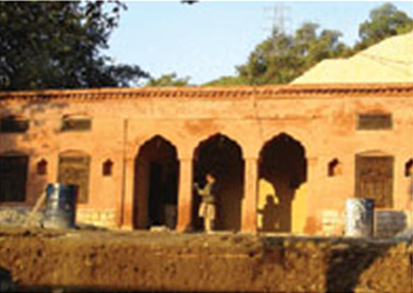Saidpur
This is a collection of articles archived for the excellence of their content. Readers will be able to edit existing articles and post new articles directly |
Saidpur
Tourism taking precedence over tradition
By Huma Khawar
Saidpur, a heritage village, is located off the Hill Road to the east of Daman-e-Koh in the heart of the capital. Saidpur is a cultural tourist’s delight, with its narrow streets, the old market, the Hindu temple and the Zinda Pir’s seat of worship.
To gain a truly spiritual experience, one has to visit the Zinda Pir’s bethak (seat of worship) in Saidpur village on Thursdays. Zinda Pir or living saint is revered all over Pakistan. Villagers of Saidpur believe that he chose this spot as a place of worship and meditation. One can see different types of banyan trees around the shrine, which over the centuries have intertwined branches and roots spread wide.
The Punjab Gazetteer of Rawalpindi District, 1893 describes it in the following words: “Another fair takes place at Saidpur, a very small village at the foot of the Margalla range with beautiful springs of water. This is a Hindu fair, the shrine being known as Ram kund. This is attended by about 8,000 persons annually. Raja Ram Chandar is said to have come to this spot in his wanderings with his companions, for which reason the Hindus regards the place as sacred.”
It is said that it was founded by Sultan Said Khan, the son of Sultan Sarang Khan. He gave his daughter in marriage to the Mughal Prince Saleem, who later became Emperor Jehangir. It was a garden resort and a spring provided water for drinking and for watering the gardens around during the Mughal period.
There are now only two potters left in this village, Niaz Mohammad, who inherited his workshop from his father and works on a traditional wooden wheel dug in the ground, and Rahimdad, who has modified his workshop.
An extremely unique feature of this place is the shrine of a woman who used to live here over 100 years ago and used to take care of this place of worship. When she died the villagers built her shrine, giving her respect by lighting diyas at her shrine every Thursday.
There is a lot of demolition and renovation work going on in Saidpur these days. It is said that the village is being converted on the lines of French and Mexican styles, making it a tourists spot with a new look. There was a soft opening marked by a performance by the renowned folk singer Reshman.
An advertisement published in December last year invited expression of interest for ‘Eating places at Saidpur village’, in which proposals were invited for international café franchise, and Pakistan and continental restaurants. This turning of a heritage village into another food street was very disturbing news for the environmentalists and the conservationist of Islamabad. Artists believe this to be, “in contrast to the very concept of conservation and restoration, and contempt for our own rich heritage, glimpses of which are still alive in Saidpur.”
With a formal approval of Rs400 million for Saidpur Tourist Village Project, the old-fashioned village -- famous for its pottery – is now being converted into a tourist spot. According to the report prepared by the CDA, a temple in the village will need renovation while some schools will have to be relocated. For the purpose of relocation of the institutions, the issue has been raised with the authorities of the education department.
The Hindu temple, as mentioned in the Gazetteer, has historical significance, and, unfortunately, without experts in the field of conservation to give proper advice, two rooms which were originally the ‘orphanage’ have been demolished and a new look is being given to the temple too. There are two shops on display in Saidpur as a sample of the new facelift this village is going to have. It has niches made from Taxila stone carvers. The only use of schist stone in some of the old houses is the stone base of a wooden pillar. Most of the old houses have a very strong tradition of clay, where one witnesses extensive use of fired clay bricks and decorative motifs all made out of it.
Fauzia Minallah, an artist based in Islamabad and known for her stone work, has worked with Rahimdad to revive some of the lost clay traditions of Saidpur. “Instead of employing the stone carvers, the sample shown by the CDA should have involved the craftsmen in the restoration work right from inception – the craftsmanship of the two potters who are right there in the village. They have the knowledge to revive some of the lost clay traditions of this village,” she stresses.
She is afraid that the craft will ultimately die and once the inhabitants of the village leave the place, it will be a loss of centuries old traditions unique to Saidpur. They hope the tourist village is developed, respecting and understanding the traditions and customs of this village that need to be preserved and promoted.
